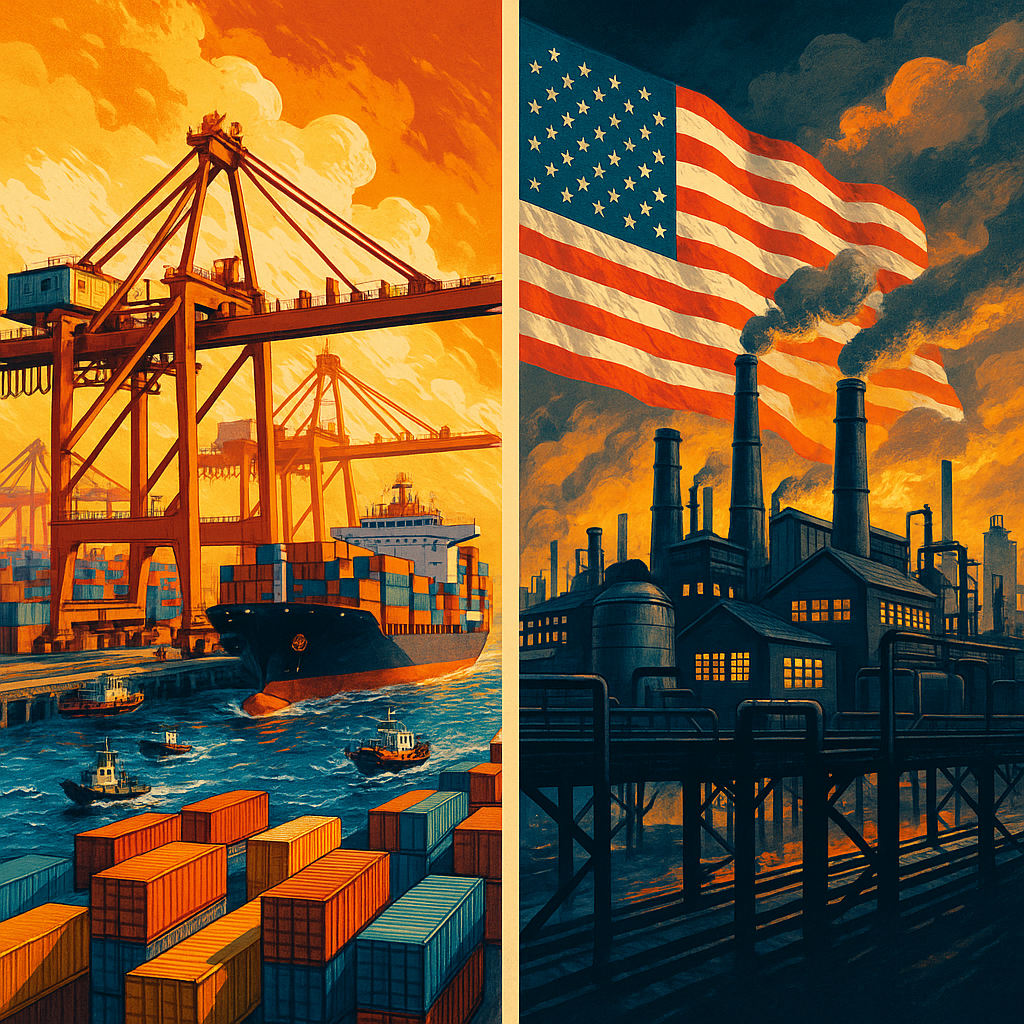On a muggy morning in early August 2025, traders in Mumbai’s bustling Zaveri Bazaar were stunned. Shipments of silver jewellery bound for the United States had just been slapped with a 25 percent tariff. It was not just a blow to the merchants. It was the latest sign that the world’s largest economy was reshaping the rules of global trade in real time.
From the industrial towns of northern England to semiconductor foundries in Taiwan, the tremors from Washington’s “reciprocal tariffs” are rattling economies large and small. The new rules mean that if a country imposes high barriers on US goods, America will match or exceed those barriers in return.
It sounds like tough negotiation. But behind the political slogans and confident podium pronouncements lies a complex economic story. The data show this is not a simple “win for America” or “loss for the world”. The truth is far more nuanced, and far more consequential.
A new global trade order
On 2 April 2025, the Trump administration announced its “Liberation Day” reciprocal tariff policy. The aim, according to the White House, was to “level the playing field” for American exporters and correct what it sees as decades of unfair trade practices.
Under the new system, US tariffs vary country by country, depending on Washington’s assessment of each nation’s average trade barriers. Rates range from 10 percent for some close allies to a punishing 41 percent for countries at the top of the administration’s “worst offenders” list. China and Syria sit at the maximum tier.
India, once a special trading partner under the Generalized System of Preferences, now finds itself facing a 25 percent tariff on most exports to the United States. An additional penalty applies because New Delhi continues to buy Russian energy and defence equipment.
The shift is not just about economics. It signals that tariffs are now a permanent instrument of US foreign policy. They are a lever not only to protect industries but also to influence geopolitical alignment.
The US strategy and its stated aims
The Trump administration frames these tariffs as a matter of fairness and sovereignty. Officials argue that American companies face higher barriers abroad than foreign exporters face in the US.
“We are no longer going to let countries take advantage of us,” President Trump declared in a July press conference. “If they put up a wall to our goods, we will match it, and then some.”
The official rationale blends economic nationalism with a strong dose of geopolitics. Beyond “reciprocity”, the policy penalises countries for aligning with strategic rivals like Russia. It also seeks to nudge manufacturing back to US soil, reduce dependency on global supply chains, and address persistent trade deficits.
The science behind the tariffs
Researchers at the Centre of Policy Studies at Victoria University in Melbourne used the GTAP-FIN global economic model to simulate the effects of the March–April 2025 US tariff increases. They modelled three scenarios:
- No retaliation by US trade partners.
- Full retaliation by all except Australia.
- Retaliation plus US fiscal consolidation, where tariff revenue is used to reduce the budget deficit.
Across all scenarios, US real GDP declines. The main drivers are short-term job losses, long-term capital stock reductions, and persistent efficiency losses in production and consumption.
Winners and losers in the global economy
The modelling reveals a complex web of outcomes. Without retaliation, US consumers initially benefit from better terms of trade, essentially getting more value for each unit of export. But when trading partners respond in kind, those gains disappear.
Australia stands out as a rare beneficiary under retaliation scenarios, thanks to improved terms of trade when US exports are diverted to its market. Vietnam, Canada, and Mexico suffer some of the largest projected consumption losses due to high tariff exposure and reliance on the US market.
China faces sustained terms-of-trade and consumption losses, especially given its 41 percent tariff rate. India’s GDP losses are smaller in percentage terms but still significant for key export sectors such as pharmaceuticals, jewellery, and shrimp.
How India fits into the picture
For India, the stakes are both economic and strategic. The 25 percent tariff applies across most sectors, from textiles to steel, and an additional penalty is tied to its Russian energy purchases.
India has responded cautiously, signalling it will defend its economic interests while keeping diplomatic channels open. Yet exporters, especially in sectors like gems and jewellery, fear a loss of competitiveness in their most lucrative market.
In 2019, the US removed India from its GSP programme, which had allowed duty-free access for $5.6 billion worth of goods. The new tariffs deepen that loss, threatening to slow India’s export growth at a time when it is trying to position itself as a manufacturing alternative to China.
A closer look at the numbers
The GTAP-FIN projections show that under the retaliation scenario:
- US real GDP averages -1.74% below baseline.
- US export volumes drop by about 33%.
- India’s real consumption falls modestly, averaging -0.02% deviation.
- Vietnam’s real consumption drops by more than 4% initially.
Under retaliation plus fiscal consolidation, the US narrows its trade deficit but suffers deeper consumption losses, while many other countries, including Australia and parts of Latin America, see slight improvements in investment and consumption due to higher global savings.
The geopolitical play
Tariffs are now a front-line tool in US foreign policy. They serve as both carrot and stick, influencing how countries align on issues from technology supply chains to defence cooperation.
By penalising trade with Russia, the US is signalling that its economic policy is inseparable from its security policy. The effect is to create a parallel “tariff diplomacy” track, where economic costs are imposed to achieve political goals.
Global supply chains, still recovering from pandemic disruptions, face renewed uncertainty. Manufacturers dependent on cross-border components are already reporting higher costs.
The GTAP-FIN study warns that investor uncertainty could amplify the economic damage beyond the model’s projections. If businesses delay investment due to unpredictable trade rules, the long-term productivity hit could be severe.
Inflationary pressures are another risk. Higher tariffs mean higher input costs, which can ripple through to consumer prices, particularly in sectors like electronics, automobiles, and food.
What happens next?
Trade partners are already filing disputes at the World Trade Organization. Some are exploring targeted retaliation against politically sensitive US exports, such as agricultural goods from swing states.
The US administration is signalling that it will consider exemptions, but only in exchange for concrete market-access concessions. That means the next few months will be a high-stakes negotiation phase, with billions in trade flows hanging in the balance.
The new US tariff regime is more than a change in tax rates. It is a restructuring of the global trading system, with consequences that will play out for years.
The data show no one walks away unscathed. Even in countries that see short-term gains, the broader system is becoming more fragmented and unpredictable.
For policymakers, the challenge is whether to double down on a fracturing global order or work towards new agreements that balance fairness with stability. For citizens, the question is simpler but no less urgent: how much are we willing to pay, in higher prices, fewer choices, and slower growth, for the promise of “fair trade”?
Reference
Giesecke, J., & Waschik, R. (2025). Economic analysis of U.S. tariffs introduced over March–April 2025. Centre of Policy Studies, Victoria University. https://doi.org/10.21642/JGEA.060201AF
Politico. (2025, July 30). ‘All things not good!’: Trump says he’s imposing 25 percent tariff on India. Retrieved from https://www.politico.com/news/2025/07/30/all-things-not-good-trump-says-hes-imposing-25-percent-tariff-on-india-00483243
White House. (2025, April 2). Regulating imports with a reciprocal tariff to rectify trade practices that contribute to large and persistent annual United States goods trade deficits. Retrieved from https://www.whitehouse.gov/presidential-actions/2025/04/regulating-imports-with-a-reciprocal-tariff-to-rectify-trade-practices-that-contribute-to-large-and-persistent-annual-united-states-goods-trade-deficits







